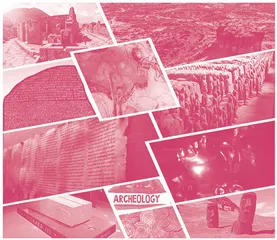Top Ten Archaeological Discoveries十大考古发现
作者: 雷萨拉特·拉希德 余璐平译

Archaeological discoveries unravel secrets and challenge our ideas about human history. Here are ten discoveries that do that and more.
考古发现可以揭示奥秘,挑战人类对自身历史的认知。以下十个考古发现带给了我们更多惊喜。
Pompeii
庞贝古城
After a devastating volcanic eruption of Mt. Vesuvius1 in 79 AD, Pompeii—an ancient Roman city—was buried under ash and pumice. The eruption destroyed the city and killed its inhabitants, a tragic story but one that left us with a vast archaeological site and a hoard of Roman treasure.
公元79年,维苏威火山毁灭性大爆发,火山灰和浮石掩埋了古罗马城市庞贝。突如其来的火山爆发让这座城市毁于一旦,城中居民全部丧生。这是一个悲剧事件,却留下了一处大型考古遗址和一批罗马宝藏。
Buried under ash means no air and moisture, so buildings, objects and cadavers have stayed well-preserved for thousands of years. A great deal of our knowledge of everyday life in a Roman city is owed to the very existence of Pompeii.
火山灰阻隔了空气和水分,因而城中的建筑、物品和尸骸得以完好保存近两千年。庞贝古城让人们得以广泛了解古罗马城市的日常生活。
Tutankhamun’s tomb
图坦卡蒙陵墓
The great Tutankhamun owes his fame to Howard Carter and George Herbert2’s discovery of his tomb in 1922. KV623 (the Egyptian designation for the tomb) was uncovered fairly intact in the Valley of the Kings.
1922年,霍华德·卡特和乔治·赫伯特发现图坦卡蒙陵墓,使这位法老蜚声世界。KV62号墓室(图坦卡蒙陵墓在埃及的编号名称)在帝王谷被发现时保存相当完好。
Although small in size and seemingly intended for a private individual rather than royalty, the tomb contained over 2,000 pieces of valuable antiques. Tutankhamun remains a worldwide symbol and sparks renewed interest in Ancient Egypt every day. It was a great find that contributed a significant deal to archaeological awareness.
尽管图坦卡蒙陵墓规模不大,似是私人墓地而非王室陵墓,但墓穴中的珍贵文物超过了2000件。图坦卡蒙一直闻名世界,颇具代表性,时常促使人们重燃对古埃及的兴趣。这是一项对提升考古认知贡献巨大的伟大发现。
Rosetta Stone
罗塞塔石碑
Dating back to 196 BC, the Rosetta Stone was inscribed with a decree from the Ptolemaic King Ptolemy V, inscribed in three languages: Ancient Egyptian hieroglyphs, Demotic script and Ancient Greek.
罗塞塔石碑的历史可以追溯到公元前196年,石碑上刻有古埃及国王托勒密五世的诏书,碑文由三种文字镌刻而成:埃及象形文圣书体、俗体文世俗体和古希腊文。
Its discovery in 1799 made it the first Ancient Egyptian bilingual text uncovered in modern times. The language had previously been impossible to decipher and a bilingual find of this kind meant we could begin to make sense of hieroglyphs. We can now translate almost any artefact with Ancient Egyptian hieroglyphs thanks to the discovery of the Rosetta Stone.
1799年,罗塞塔石碑出土,碑文成为现代发现的第一份古埃及双语文本。在此之前,人们无法破译古埃及文字,而发现这种双语对照文本则意味着,人们可以开始解读古埃及象形文字了。罗塞塔石碑的出土使几乎任何刻有古埃及象形文字的文物都可能被破译。
Terracotta Army
兵马俑
The Terracotta Army is a mesmerising4 collection of terracotta sculptures depicting the armies of China’s first emperor, Qin Shi Huang. It’s an example of funerary art made with the symbolic intention of protecting the emperor in his afterlife.
兵马俑是成批的陶制雕塑,呈现了中国第一位皇帝秦始皇军队的风采,引人入胜。这是丧葬艺术的范例,象征在秦始皇死后保卫他的安全。
The army dates from the third century BC and numbers approximately 8,000 soldiers, 130 chariots and 520 horses. It tells us a lot about how Chinese soldiers were equipped at the time, the weapons they used and the clothes they wore.
兵马俑代表的这支军队可以追溯到公元前3世纪,约由8000名士兵、130辆战车和520匹战马组成。它展现了当时中国军队的装备、武器和战袍,让人们了解了很多相关知识。
Richard III’s grave
理查三世之墓
The last Plantagenet King of England, Richard III’s reputation as a prince5 killer, crookback, and all-round nasty power grabber is a mainstay of English folklore. Despite his infamy, his burial site remained a mystery until the Looking for Richard project in 2012.
理查三世是英国金雀花王朝的末代国王,英国民间流传着有关这个驼背暴君杀侄篡位、不择手段攫取权力的大量传说。尽管理查三世声名狼藉,他的陵墓位置一直是个谜,直到2012年发起“寻找理查”项目,才确定他的安葬地。
With the help from the University of Leicester’s archaeological services, the project uncovered human remains within the site of the former Greyfriars Friary Church in Leicester. The remains were tested and scientifically proven to be those of Richard III, attracting much media attention.
在莱斯特大学考古团队的帮助下,“寻找理查”项目的研究人员在莱斯特市原方济会男修道院教堂遗址发现一具人类遗骸。经过科学测试,研究人员确认这具遗骨的身份正是理查三世,引发媒体广泛关注。
Olduvai Gorge
奥杜威峡谷
This 30-mile section of Tanzania’s Rift Valley is responsible for much of what we know about the evolution of hominins and eventual existence of our species. Fossil remains found in Olduvai Gorge show that precursor human species date as far back as 1.9 million years ago.
奥杜威峡谷长约30英里,是坦桑尼亚境内东非大裂谷的一段,对了解古人类进化历程及人类最终生存形态有重要的价值。在奥杜威峡谷发现的遗骨化石表明,人类远祖可以追溯到190万年前。
They also show how we’ve increased in social and cognitive complexity through stone tool use and a hunter-gatherer lifestyle. Tools and animal remains found in a central area indicated developing social interaction and these phenomena are seen in increasing fashion in the more recent remains. Our species, homo sapiens, are thought to have occupied the site from around 17,000 years ago.
这些遗骨和遗迹还表明,通过使用石器工具和采取狩猎采集的生活方式,人类的社会和认知复杂度有所提高。在峡谷中心地带发现的工具和动物遗骸表明社会性互动在逐步发展,而这类现象在更晩近的遗迹中愈发常见。据考证,现代人类所属物种“智人”,约17000年前生活聚居在此。
Cave of Altamira
阿尔塔米拉洞窟